A rock garden, also known as a rockery, is a unique landscape design that incorporates a variety of rocks, stones, and plants. These gardens create a stunning visual display, with the focus on both the stone formations and the plants that inhabit the space.
To make your rock garden truly stand out, incorporating colourful plants is key to offset the aesthetically arranged rocks. In this article, we'll explore a range of vibrant and low-maintenance plants for rockeries that add life and colour to your garden.
More...
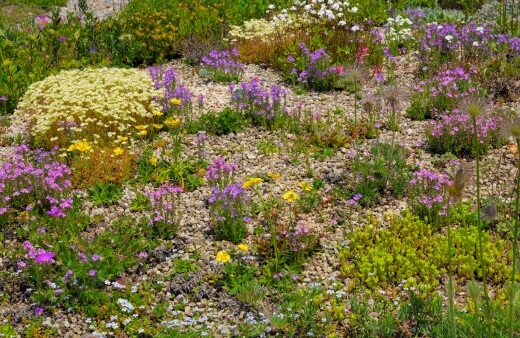
Best Plants for Rockeries in Australia
1. Sedum (Sedum spp.)
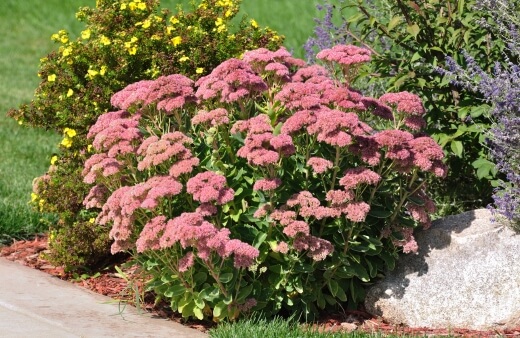
Sedums, commonly known as stonecrops, are succulent plants that thrive in rocky environments. With over 400 species, sedums offer a wide variety of colours, textures and growth habits.
Some popular species for rock gardens include:
- Sedum ‘Autumn Joy’: With its blue-green foliage and late-season, deep pink flowers, this sedum adds a burst of colour in the fall.
- Sedum ‘Coral Carpet’: This ground-covering sedum features red-tinted leaves that deepen in colour during the colder months and tiny, white summer flowers.
- Sedum rupestre ‘Angelina’: This low-growing sedum has needle-like foliage in a bright, golden-yellow hue that becomes tinged with orange in the fall.
2. Ice Plant (Delosperma spp.)
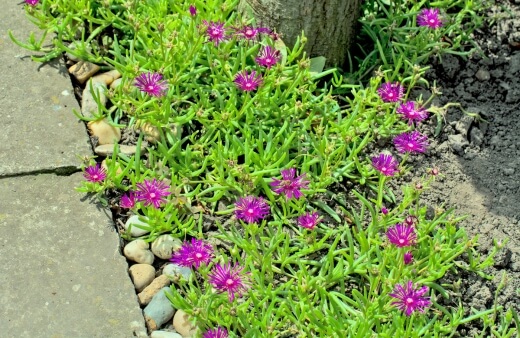
Delosperma, or ice plant, is a ground-hugging succulent with fleshy, evergreen leaves and daisy-like flowers. These sun-loving plants are ideal for adding a pop of colour to rock gardens.
Some striking varieties include:
- Delosperma cooperi: This ice plant produces a carpet of vibrant purple flowers throughout the summer.
- Delosperma ‘Fire Spinner’: With a mix of orange, red, and lavender flowers, this ice plant variety is truly eye-catching.
- Delosperma ‘Jewel of Desert Grenade’: This cultivar is known for its large, fuchsia flowers with contrasting yellow centres.
3. Rock Rose (Helianthemum spp.)
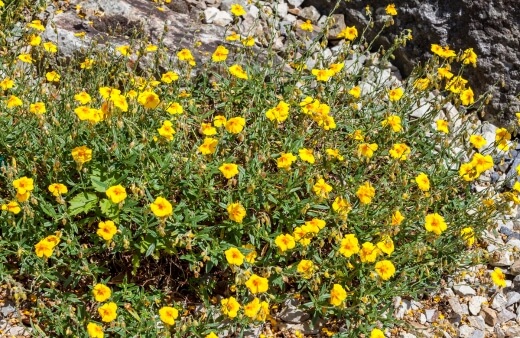
Rock roses are a group of small, sun-loving shrubs that feature bright, saucer-shaped flowers. Their blossoms come in a variety of colours, including shades of red, orange, pink, and yellow.
Some colourful examples are:
- Helianthemum ‘Ben Fhada’: This rock rose is known for its large, bright yellow flowers with a striking orange-red centre.
- Helianthemum ‘Henfield Brilliant’: Featuring intense, coppery-orange flowers, this rock rose is a showstopper.
- Helianthemum ‘The Bride’: With its delicate, white flowers and contrasting maroon central blotch, this cultivar adds elegance to any rock garden.
4. Dwarf Iris (Iris reticulata)

Dwarf irises are small, bulbous plants that produce striking, colourful flowers in early spring. Their compact size makes them perfect for rock gardens.
Some standout varieties include:
- Iris reticulata ‘Pixie’: This cultivar features deep purple flowers with a bright yellow centre.
- Iris reticulata ‘Harmony’: With its vibrant blue flowers and bright orange accents, this dwarf iris is truly enchanting.
- Iris reticulata ‘Pauline’: This variety boasts rich, velvety-purple flowers with a contrasting yellow central stripe.
Check out our growing guide to learn more about Irises and its different varieties.
5. Creeping Phlox (Phlox subulata)
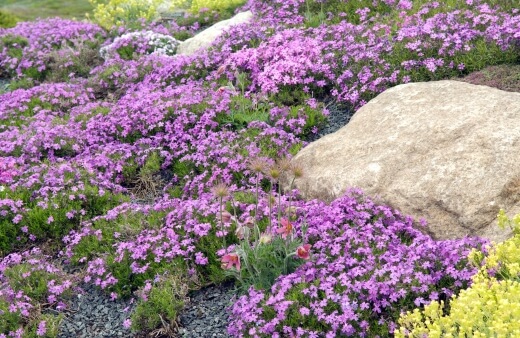
Creeping phlox is a low-growing, evergreen perennial with a carpet-like growth habit. It's ideal for covering ground in a rock garden and produces masses of small, star-shaped flowers in spring.
Some colourful cultivars include:
- Phlox subulata ‘Emerald Blue’: This variety is known for its abundant, light blue flowers that create a stunning display.
- Phlox subulata ‘Scarlet Flame’: With its vibrant, red-pink flowers, this creeping phlox adds a fiery touch to your rock garden.
- Phlox subulata ‘Candy Stripe’: This cultivar features charming, white flowers with a pink stripe down the centre of each petal.
6. Aubrieta (Aubrieta deltoidea)

Aubrieta, also known as rock cress, is a low-growing, spreading perennial that forms a dense mat of evergreen foliage. Its small, four-petaled flowers appear in spring and come in shades of purple, pink, and blue.
Some popular varieties include:
- Aubrieta deltoidea ‘Royal Blue’: This cultivar produces deep blue flowers that contrast beautifully with its grey-green foliage.
- Aubrieta deltoidea ‘Red Carpet’: As the name suggests, this variety features rich, red flowers that create a striking visual impact.
- Aubrieta deltoidea ‘Cascade Purple’: This variety is known for its profusion of purple flowers that cascade over rocks and walls.
7. Thrift (Armeria maritima)
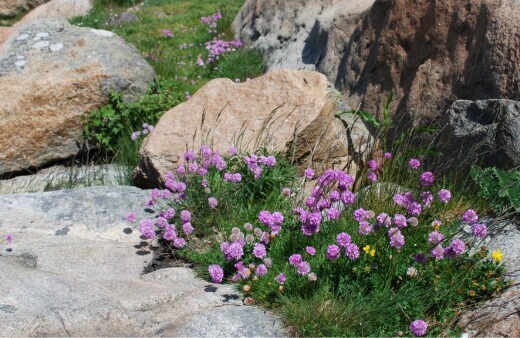
Thrift, also known as sea pink, is a low-growing, tufted perennial with grass-like foliage. Its round, pom-pom-like flowers appear on tall, slender stems and come in shades of pink, red, and white.
Some attractive cultivars for rock gardens include:
- Armeria maritima ‘Rubrifolia’: This variety boasts reddish-purple foliage and vibrant pink flowers.
- Armeria maritima ‘Alba’: With its pure white flowers, this cultivar adds a touch of elegance to any rock garden.
- Armeria maritima ‘Splendens’: This cultivar is known for its deep pink flowers that create a stunning contrast with its dark green foliage.
8. Pasque Flower (Pulsatilla spp.)
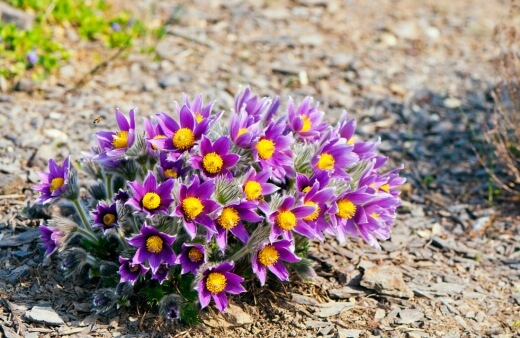
Pasque flowers are clump-forming perennials with finely dissected, fern-like foliage. Their distinctive, bell-shaped flowers appear in spring and come in shades of purple, blue, red and white.
Some eye-catching pasque flowers as rockery garden plants include:
- Pulsatilla vulgaris ‘Blaue Glocke’: This cultivar produces large, violet-blue flowers with a striking yellow centre.
- Pulsatilla vulgaris ‘Rote Glocke’: With its rich, red flowers and contrasting yellow centre, this pasque flower is a standout.
- Pulsatilla vulgaris ‘Alba’: This variety features elegant, white flowers with a soft yellow centre.
Rockery Plants that are Dangerous for Pets
It’s good to consider whether your garden would be safe for pets. Australians love owning dogs and cats, so there’s a good chance you either have pets or have visitors who own pets.
Whether you’ve got inquisitive Golden Retriever puppies or an old Tomcat that likes to roam around, there’s always a chance that they may nibble on some of your plants.
Here's a short list of popular rock garden plants that are toxic to pets:
- Autumn Crocus (Colchicum autumnale): This plant produces beautiful, fall-blooming flowers but contains colchicine, which is toxic to dogs and can cause severe gastrointestinal issues and organ damage.
- Foxglove (Digitalis purpurea): Foxglove is a striking plant with tall spikes of tubular flowers, but it contains cardiac glycosides that can be highly toxic to dogs, causing heart problems, tremors, and even death.
- Lily of the Valley (Convallaria majalis): This low-growing plant with bell-shaped flowers is highly toxic to dogs due to the presence of cardiac glycosides, which can lead to heart problems, vomiting, diarrhoea, and potentially death.
- Monkshood (Aconitum napellus): Monkshood produces tall spikes of blue, purple, or white flowers but contains aconitine, which is highly toxic to dogs and can cause symptoms such as vomiting, diarrhoea, heart problems, paralysis, and death.
- Oleander (Nerium oleander): Although not commonly used in rock gardens, oleander is a drought-tolerant plant with beautiful flowers that can be highly toxic to dogs due to the presence of cardiac glycosides, which can lead to serious heart problems and even death.
Please note that this list is not exhaustive. If you have a dog, cat or other pets that might have access to your rock garden, it's crucial to research the plants you're considering and consult with your veterinarian for guidance on pet-safe options.
For more roundup of different types of plants, refer to our list below:
Take Your Pick from these Colourful Plants for Rockeries
A well-designed rock garden can be a visually appealing addition to any landscape. It’s possible to create a stunning and dynamic rock garden that will capture the eye and imagination, so long as you make good use of plants and the natural features of your property.
The plants listed in this article are just a few of the many colourful options available for your rock garden. With proper care and maintenance, these vibrant selection of plants for rockeries will ensure that your garden remains a dazzling focal point of your property for years to come.
Published on April 1, 2023 by Maisie Blevins
Last Updated on January 29, 2024




